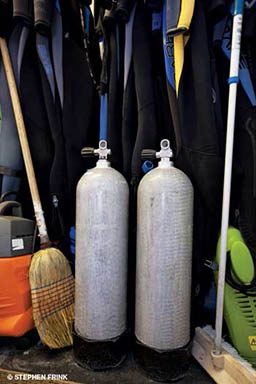Q: After some recent dives, some of my toes were really sore. Within a few hours they looked bruised and were extremely painful; I could hardly walk. It took several days for the bruising and pain to go away. Could this have been decompression sickness (DCS)?
A: This was unlikely to have been DCS due to the location and the symptoms you described. DCS symptoms are not known to isolate in specific digits. Your presentation suggests a condition known as reactive hyperemia, which may result after a period of reduced blood flow to an area of the body. When circulation is fully restored following constriction, the blood vessels dilate and may become engorged with blood. This can cause discoloration ranging from dark red to the bruised appearance you described as well as intense pain.
If fin straps are too tight or a diver forces his foot into the foot pocket too firmly, a steady mechanical pressure on the blood vessels may result. This is colloquially known as “fin foot.” Colder water may also contribute to the constriction of the blood vessels, further reducing blood flow to the area. Usually this condition does not require medical intervention other than pain management. Staying off the affected foot as much as possible, elevating it and applying warm compresses will typically improve comfort. Ensure proper fit of your booties and fins, and don’t overtighten heel straps.
— Marty McCafferty, EMT-P, DMT

Q: I have some tanks in my garage that are filled to 3,000 psi, and I have not used them in many months. Is there any hazard to breathing the air in these tanks after a prolonged period? Does the air in them need to be replaced after a certain amount of time?
A: We’re not aware of any studies that address this issue specifically. To comply with recommended safety guidelines, all scuba cylinders should be visually inspected annually. The gas in the cylinder is replaced in the course of the visual inspection. Experts have discussed whether air in a cylinder can actually “go bad,” but without any data, arguments for or against using the air after a prolonged period are purely speculative. There is no clear mechanism to explain why the air would not be suitable for use, and any theoretical risk is avoided by the annual inspection.
— Marty McCafferty, EMT-P, DMT
Q: On a recent liveaboard dive trip to the South Pacific, I encountered some unusual instructions regarding dive profiles. In the briefing for the day’s first dive we were told the second dive would involve a short swim-through at 90 feet. Because of this, the divemaster wanted everyone to go to 110 feet on the first dive — even though there was nothing to see at that depth — for the sole purpose of ensuring the day’s dives were progressively shallower. Was there any good reason for this recommendation?

A: The strategy you described (making an unnecessarily deep dive first simply to maintain a progressively shallower dive series) was unwarranted. The additional inert-gas burden would unnecessarily increase decompression risk. Diving to appropriate depths for each dive and maintaining respect for decompression limits are far more prudent.
While the concept of making progressively shallower dives makes intuitive sense and is generally recommended, evidence for any real benefit is difficult to find, and, even more important, real-life conditions must be considered. Think about a first dive following a layoff from diving. Arbitrarily applying a deepest-dive-first rule would clearly be unwise.
Your thoughtfulness in asking questions is the most promising for your long-term safety. Clear and critical thinking should always be part of a dive kit. Divers should remember that when they look at dive computer screens. The box will never get DCS. The respect for decompression limits I mentioned earlier is best achieved by adding conservatism as inexpensive insurance against having a bad day. Computers and general practice provide guidelines; we have to bring the common sense.
— Neal W. Pollock, Ph.D.
Q: We are flying to Cook Island and will arrive at 6 a.m. Some members of our group want to dive right away, but others say we should wait 24 hours. I understand that being tired from flying may be a risk factor, but is flying itself a risk?
A: Unlike flying after diving, no clear nitrogen-related problem exists with diving after flying. However, there are some issues that warrant careful consideration before diving soon after a flight. The more time zones you cross, the more prudent it is to wait. Seldom after lengthy trips are we well rested, optimally hydrated and properly nourished. Fatigue can be an insidious risk factor. When you arrive at your destination, honestly assess your fitness at that time. Jet lag, stress, soreness and fatigue can compromise safety. Muscle cramps and joint pain due to recent air travel might even be mistaken for DCS if they are first noticed after a dive. It is prudent to wait to dive until you have fully recuperated from the trip and are mentally and physically ready. Don’t let enthusiasm for diving lead you to a potentially unwise choice.
— Marty McCafferty, EMT-P, DMT
Q: Now that I have decided to stop smoking, what impact might smoking-cessation medications have on my return to diving?

A: The benefits of quitting smoking will generally outweigh any side effects or complications from drugs used to help you quit. According to the Mayo Clinic, “Your health will benefit almost immediately if you stop smoking. Just 20 minutes after your last cigarette, your heart rate goes down. Twelve hours later, levels of carbon monoxide, a toxic gas, in your blood return to normal. Your lung function improves, and your circulation starts to get better within three months. After a year, your risk of having a heart attack drops by half. And after five to 15 years, your stroke risk will be the same as that of a nonsmoker.”
Before quitting successfully, most smokers make several unsuccessful attempts; it’s rare to succeed on your first try. Both counseling and medications have been shown to help smokers quit. Some medications provide nicotine to help reduce cravings and limit withdrawal symptoms, which include irritability and anxiety. These medications are available over the counter in the form of patches, gum and lozenges.
Prescription medications such as bupropion (Zyban or Wellbutrin) and varenicline (Chantix) are also used to support smokers’ attempts to stop. Neither these medications nor the nicotine-replacement therapies have been tested in the context of diving. But as with other medications, it is a good idea to take any drug for a significant period (30 days, for example) before diving with it. This helps minimize the risk of unexpected side effects occurring for the first time underwater; it also ensures the dosage adequately treats the symptoms of nicotine withdrawal. Serious side effects with bupropion and varenicline are not common, but they are possible.
If you experience any unusual symptoms during a dive, end the dive and discuss them with your doctor before diving again. The doctor may be able to work with you to find a more suitable medication.
— John U. Lee, EMT, DMT, CHT
© Alert Diver — Q4 Fall 2012